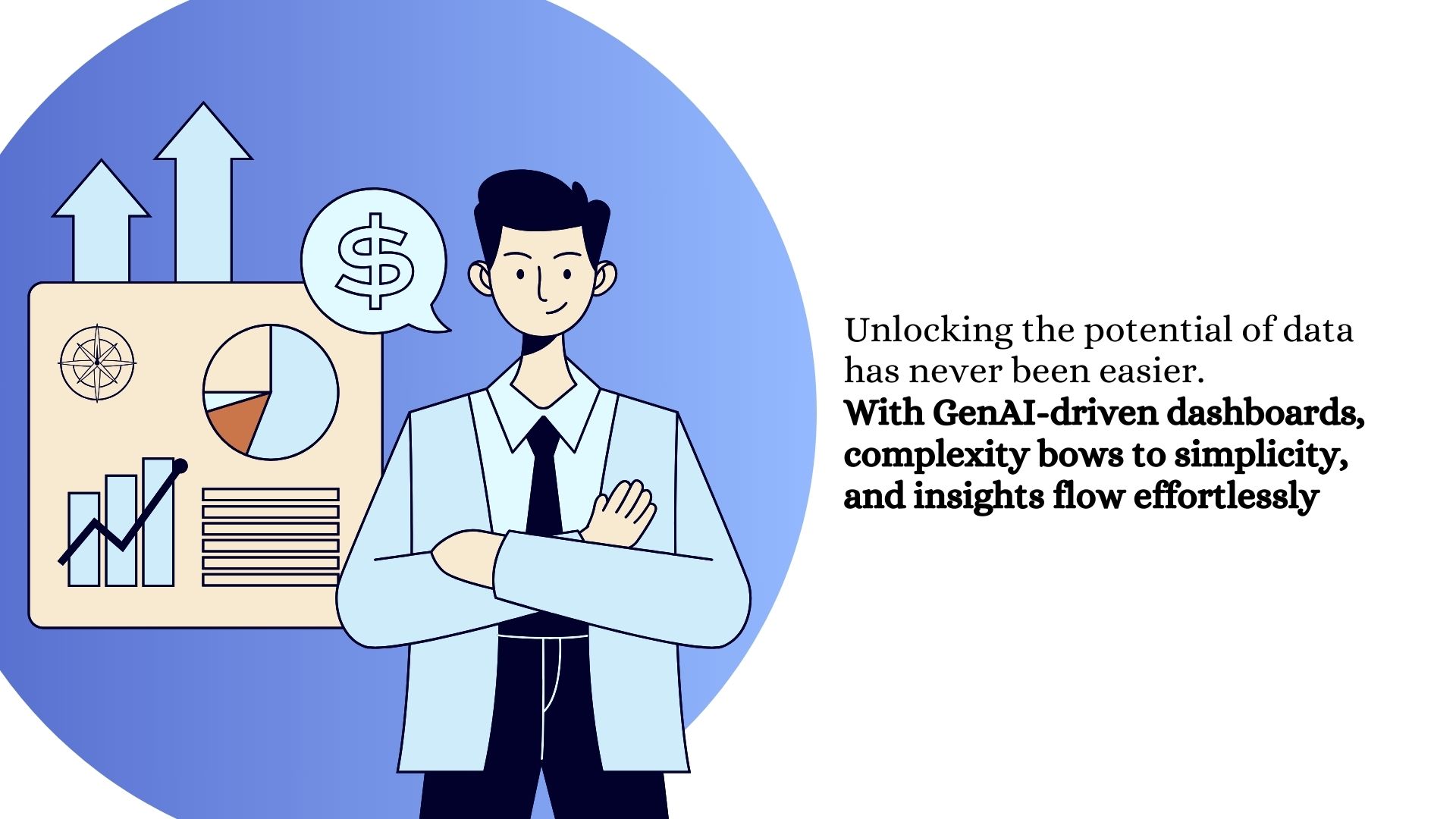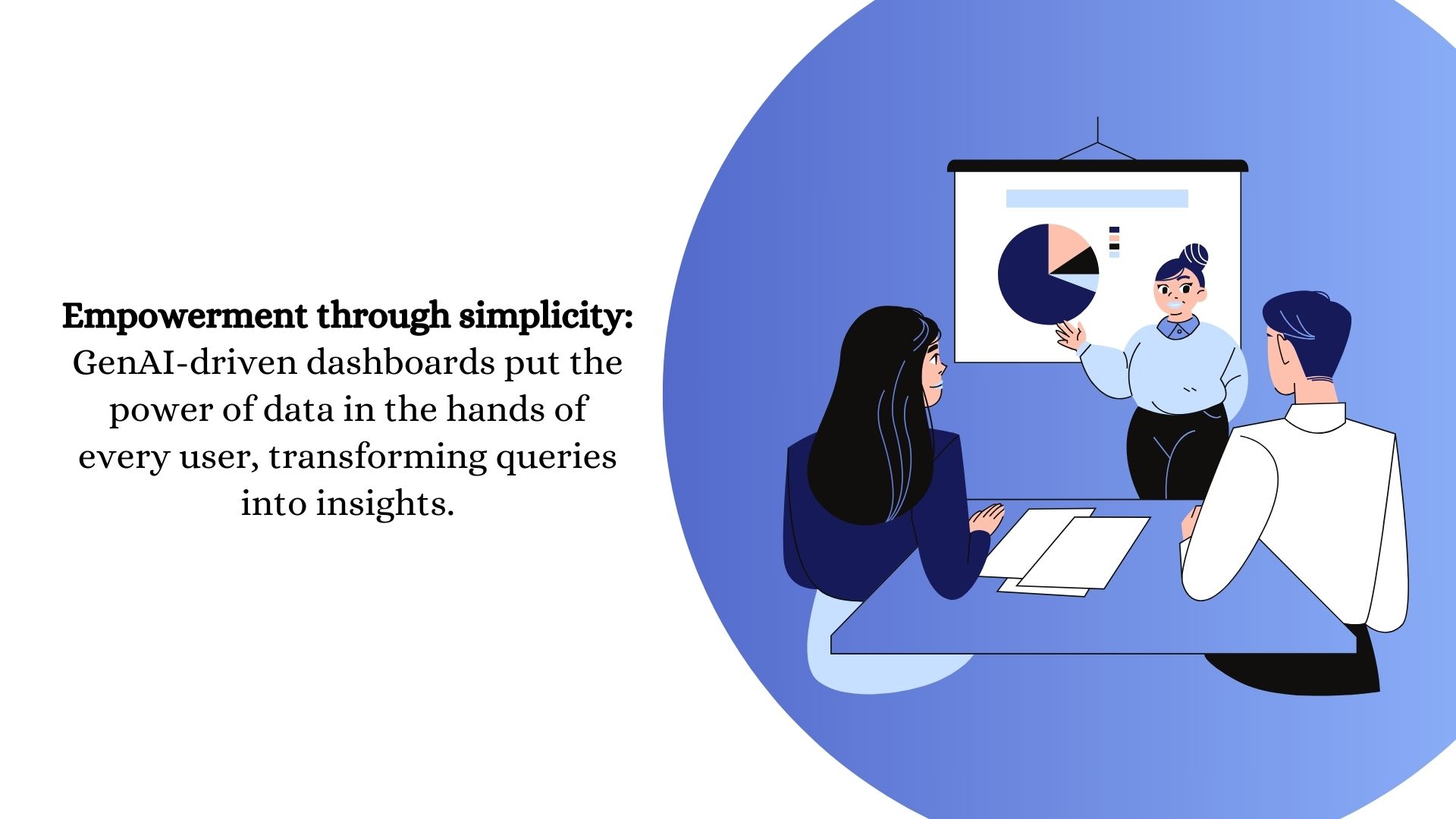- Home
- Generative BI
- Unleash the Power of Data with ...
Table of Contents
Introduction

The demand for intuitive and efficient dashboard solutions is ever-growing. Traditional methods often involve manual creation and customization, which can be time-consuming and prone to errors. However, with the advent of Artificial Intelligence (AI) and Machine Learning (ML), a new era of dashboard creation has emerged, powered by GenAI-driven technologies and Conversational BI.
Imagine a dashboard engine that can effortlessly transform your Data with just three inputs—Widget Name, Chart Type, and Data Question—into a comprehensive dashboard with advanced features like Drill Down and Slice & Dice capabilities. This is not a distant dream but a reality enabled by cutting-edge AI and ML algorithms.
The Rise of GenAI-Driven Dashboards
GenAI-driven Conversational BI’s dashboards represent a paradigm shift in how organizations harness data for decision-making. By leveraging the power of AI and ML, these dashboards streamline the process of dashboard creation and customization, empowering users to extract actionable insights from complex datasets with ease.
At the heart of GenAI-driven dashboards is their ability to understand and interpret user inputs through natural language processing (NLP) algorithms. This enables users to communicate with the dashboard in plain language, eliminating the need for technical expertise or coding skills. Whether it’s specifying the type of visualization or asking complex data-related queries, users can interact with the dashboard as they would with a human analyst.
Conversational BI: Bridging the Gap
Conversational BI serves as the bridge between users and data, facilitating seamless communication and interaction. Instead of struggling with intricate dashboard interfaces or struggling with complex data queries, users can simply converse with the dashboard, articulating their requirements in natural language.
This Conversational BI interface not only enhances user experience but also accelerates the pace of insights generation. Users can quickly iterate through different visualization options, refine their queries on the fly, and explore underlying data patterns in real time—all through intuitive conversations with the dashboard.
The Three Inputs: Unlocking Dashboard Potential

The simplicity of GenAI-driven Conversational BI lies in their reliance on just three inputs: Widget Name, Chart Type, and Data Question. Let’s delve into each of these inputs and understand how they collectively contribute to the creation of a robust and insightful dashboard:
Widget Name
This input serves as the starting point for dashboard customization. Users can specify the type of widget they want to incorporate into their dashboard, whether it’s a line chart, bar graph, pie chart, or any other visualization format. By providing this input, users set the stage for the subsequent steps in dashboard creation.
Chart Type
Once the widget type is determined, users can further refine their preferences by specifying the chart type. Whether it’s a trend analysis, distribution comparison, or correlation exploration, users can choose the most suitable chart type to visualize their data effectively. This input ensures that the dashboard aligns with the user’s analytical objectives and presentation preferences.
Data Question
Perhaps the most critical input, the data question encapsulates the user’s inquiry or analysis objective. Users can pose questions or specify data criteria in natural language, such as “Show me sales trends by region over the past year” or “Compare customer satisfaction scores across product categories.” The dashboard engine leverages NLP algorithms to interpret these queries, retrieve relevant data, and generate insightful visualizations accordingly.
Automated Features: Enhancing Analytical Capabilities
Beyond basic visualization, GenAI-driven Conversational BI offer a suite of automated features that enrich the analytical experience:
Drill Down
Users can delve deeper into specific data points or subsets by drilling down into hierarchical layers of information. Whether it’s exploring regional sales performance or dissecting customer demographics, the drill-down feature enables granular analysis without losing sight of the big picture.
Slice & Dice
With the slice and dice feature, users can dynamically segment and filter data based on various dimensions or criteria. Whether it’s filtering sales data by product category, time, or customer segment, users can tailor their analysis to focus on specific subsets of data, uncovering actionable insights in the process.
Empowering Users, Driving Insights
In conclusion, GenAI-driven dashboards with Conversational BI represent a quantum leap in the realm of data analytics and business intelligence. By simplifying the dashboard creation process and facilitating natural language interactions, these dashboards empower users to unlock the full potential of their data assets.
With just three inputs—Widget Name, Chart Type, and Data Question—users can embark on a journey of data exploration and discovery, aided by automated features like Drill Down and Slice & Dice. The result is not just a dashboard but a powerful analytical tool that enables informed decision-making, drives business innovation, and propels organizations towards success in an increasingly data-driven world.

Apoorva is a passionate and driven individual who accidentally found her interest in Business Intelligence and Data Analysis while studying Travel and Tourism. Despite her first love for being Content Writer and Blogger, she now creates compelling content on NLP-driven decision-making and a No-Code Data Platform that influences businesses. Her commitment to making Data accessible and Democratized for everyone has led her to work with NewFangled Vision on NLP-based Conversational Driven Data Analysis.
Category
- Case Study
- CRM GenAI
- Customer Sentiment Quester
- Data Analytics
- Data Democratization
- Data Security
- Decision Enabler Platform
- Enterprise GenAI
- Excel Sheet Analytics
- Finance Modelling
- GenAI for manufacturing
- Generative AI
- Generative BI
- Log Analytics
- Media Analytics
- NewFangled
- NewFangled AI Architecture
- NewFangled VADY
- Newfangled Vision
- No-Code BI
- No-Code ETL
- PolusAI
- POS GenAI
- Real Estate Anlaytics
- Real-Time Data Analytics
- Research
- Self-Service Analytics
- Stream Analytics
- Uncategorized
- VADY

